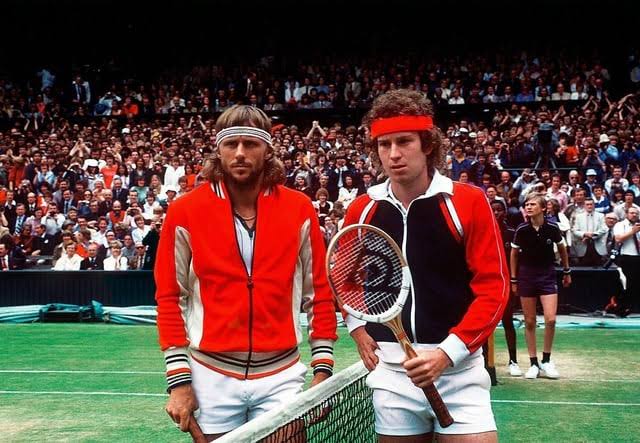US Open final 1980: the making of McEnroe and a bridge too far for Borg…
The 1980 US Open men’s singles final stands as one of the most iconic matches in tennis history—a clash of contrasting personalities, styles, and eras that encapsulated the sport’s evolving landscape. On a hot September day at the USTA National Tennis Center in Flushing Meadows, New York, a young John McEnroe faced the legendary Björn Borg in a match that would go down as a defining moment for both players and the sport itself.
**The Rise of John McEnroe**
By 1980, John McEnroe was emerging as one of the most talented and fiery young stars in tennis. Known for his exceptional touch, serve-and-volley game, and fiery temperament, McEnroe had already made waves on the tour with his exceptional skill and vocal outbursts. At just 21 years old, he was rapidly climbing the ranks, driven by an intense desire to establish himself as a champion.
McEnroe’s journey to the US Open final was marked by remarkable performances. His victory over Jimmy Connors in the semifinals was a defining moment, showcasing his ability to challenge the game’s top players. His talent was undeniable, but so was his volatility—his emotions often threatened to overshadow his brilliance. Yet, beneath the fiery exterior lay a tennis prodigy capable of producing moments of sublime artistry.
**Björn Borg: The Iceman’s Reign**
Björn Borg, by contrast, epitomized stoicism and cool calculation. The Swedish superstar had already established himself as a dominant force, winning the French Open and Wimbledon multiple times. Known as “The Iceman,” Borg’s calm demeanor on court contrasted sharply with McEnroe’s fiery temperament. His baseline game, characterized by relentless consistency and strategic shot placement, made him one of the most formidable players of his era.
Borg’s quest for a fifth consecutive US Open title was a significant storyline heading into the 1980 final. His ability to maintain composure under pressure had already earned him a reputation as one of the greatest players of all time. Yet, the US Open, played on the hard courts, represented a different challenge—one that would test his adaptability against McEnroe’s aggressive style.
**The Build-up to the Final**
The 1980 US Open final was billed as a clash of opposites—McEnroe’s fiery passion versus Borg’s icy resilience. The match carried high stakes; Borg was seeking to extend his dominance at Flushing Meadows, while McEnroe was determined to claim his first Grand Slam title and prove himself against the established legend.
Throughout the tournament, McEnroe’s flamboyant personality and exceptional talent had captivated fans and media. His confrontations with umpires and opponents had already made headlines, but on the court, his game was equally compelling. Borg, meanwhile, relied on his disciplined baseline play, unshakeable focus, and strategic mastery.
**The Match: A Tactical Battle and a Turning Point**
The 1980 final was a grueling five-set battle that lasted over four hours—a testament to the stamina and mental toughness required at the highest level. Borg took the first two sets, showcasing his mastery of the baseline game and tactical patience. His relentless consistency and ability to read McEnroe’s serve kept him ahead.
However, McEnroe’s fiery temperament and creative shot-making began to turn the tide. He fought back fiercely, winning the third set in a tiebreak with a display of agility and mental resilience. The fourth set saw Borg regroup, displaying his trademark calm and precision, forcing a decisive fifth set.
In the deciding set, McEnroe’s aggressive net play and serve became crucial. His fiery spirit and unyielding determination pushed him forward, but Borg’s unwavering focus and strategic steadiness kept him in the match. Ultimately, Borg triumphed in five sets, capturing his fifth consecutive US Open title—a feat no man had achieved before.
**A Bridge Too Far for Borg?**
While Borg’s victory reaffirmed his dominance, the match also symbolized the changing of the guard. McEnroe’s aggressive style and fiery personality represented a new era in tennis—one characterized by emotional intensity and creative shot-making. Though Borg’s victory was decisive, the match highlighted the difficulties faced by even the most disciplined champions when confronted with a player who played with relentless passion and unorthodox tactics.
For Borg, the loss was a rare blemish in an otherwise illustrious career. It demonstrated the physical and mental toll of such a grueling battle, and the challenge of overcoming a player who refused to be subdued. For McEnroe, the defeat was a stepping stone; it marked his emergence as a future rival to Borg and a transformative figure in tennis history.
**Legacy and Impact**
The 1980 US Open final remains a defining moment in tennis history, not only for its dramatic contest but also for what it represented—the clash of old and new, control and chaos, tradition and rebellion. Borg’s victory solidified his status as one of the greatest champions, while McEnroe’s fiery spirit and exceptional talent hinted at a promising future.
In the years that followed, both players would continue to shape the sport—Borg with his stoic consistency and record-breaking achievements, McEnroe with his artistic flair and fiery personality. Their rivalry, epitomized in this final, remains a testament to the diverse personalities that make tennis a compelling spectacle.
The 1980 US Open final was more than just a match; it was a turning point—a bridge too far for Borg, yet also a moment that cemented both players’ legacies as legends of the game.
–
